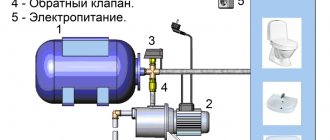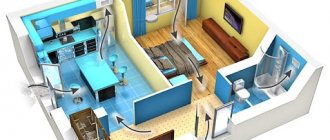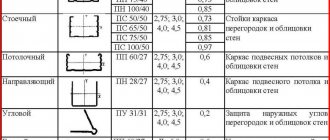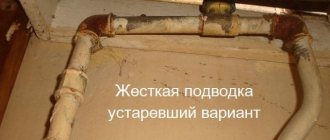Organizing a water supply system for a private home is always a troublesome process. This system includes many elements, and one of them is the hydraulic accumulator, which occupies one of the most important places in it. However, in order for the water supply system to function well, you need to know how to choose the right hydraulic accumulator. After all, the operation of the entire system will depend on this.
Let's figure out which hydraulic accumulator is suitable for a country house
Types of hydraulic water tanks, divided by location and other parameters
Let's present this section in tabular form for ease of understanding:
| Separation | Designation | Peculiarities |
| Location type | Horizontal | The volume of such tanks is larger. The vertical position allows the air release valve to be installed from above. This makes maintenance easier. The only limitation in installation is the volume of the room. |
| Vertical | Compact options in which a tap is installed to vent air. The disadvantage is that in some models you have to completely drain the water to bleed the air, which is not economical. | |
| Energy storage | Pneumatic accumulation | Diaphragm, balloon or piston. The problem arises when the partition wears out - expensive and labor-intensive repairs are required. |
| Balloon or pear | Most popular. When worn out, the pear is replaced with a new one independently, without the involvement of professionals. | |
| Mechanical storage | Weight or spring. Work is based on kinetic energy. Quite voluminous and work autonomously. |
How to choose tank volume
You can choose the tank volume arbitrarily. There are no requirements or restrictions. The larger the volume of the tank, the greater the supply of water you will have in case of a shutdown and the less often the pump will turn on.
When choosing a volume, it is worth remembering that the volume that appears in the passport is the size of the entire container. There will be almost half as much water in it. The second thing to keep in mind is the overall dimensions of the container. A 100 liter tank is a decent-sized barrel - about 850 mm high and 450 mm in diameter. You will need to find a place somewhere for it and the harness. Somewhere - this is in the room where the pipe from the pump comes. This is where all the equipment is usually installed.
If you need at least some guidelines to select the volume of a hydraulic accumulator, calculate the average flow rate from each water intake point (there are special tables or you can look at the data sheet for household appliances). Sum up all this data. Get the possible consumption if all consumers work simultaneously. Then figure out how many and which devices can work at the same time, calculate how much water will be consumed in a minute in this case. Most likely by this time you will have already come to some decision.
Selection of hydraulic accumulator
The volume of the selected accumulator tank must be greater than or equal to the volume obtained as a result of the calculation. There are no negative consequences from overestimating the volume of the hydraulic accumulator beyond the calculated value, no matter how much it is exceeded.
When selecting a hydraulic accumulator, you should take into account its temperature and strength characteristics. The maximum pressure of the tank must be greater than or equal to the maximum pressure at its connection point.
If the installation of hydraulic accumulators is planned indoors, then it should be taken into account that tanks with a diameter of more than 750 mm and a height of more than 1.5 m may not fit through the doorway, and mechanization will be required to move them. In this case, it is better to give preference to not one, but several hydraulic accumulator tanks of smaller capacity.
When choosing a hydraulic accumulator, you should remember that the volume of water stored in it is on average 40-50% of the tank volume.
Shape, dimensions
Perhaps the shape of the tank may matter to you - vertical or horizontal. For example, if the space for its installation is limited in area or height.
In addition, when using a large-volume tank, make sure in advance that its dimensions will easily fit into the doorway or choose another model. This is not difficult to do, since the choice of hydraulic accumulators from different manufacturers on our market is quite large.
Reflex
Zilmet Ultra-Pro H 24 H
Aquasystem
Gilex
Tank volume is the main selection criterion
The most important question is how to choose the volume of a hydraulic accumulator for water supply systems. To answer it, you need to bring together a lot of data. This includes the performance of the pump, the equipment of the house with water-consuming equipment, the number of people permanently living in the house, and much more.
But first of all, you need to decide whether you need this reservoir only to stabilize the operation of the system as a whole, or whether there is a need for a supply of water in case of a power outage.
Internal cylinders of different volumes
If the house is small and equipped only with a washbasin, toilet, shower and watering tap, and you do not live in it all the time, you don’t have to make complex calculations. It is enough to buy a tank with a volume of 24-50 liters, it will be enough for the system to work normally and be protected from water hammer.
In the case of a country house for permanent family residence, equipped with everything necessary for a comfortable life, it is advisable to approach the issue more responsibly. Here are a few ways you can decide on the size of your accumulator.
According to pump characteristics
The parameters that influence the choice of tank volume are the performance and power of the pump, as well as the recommended number of on/off cycles.
- The higher the power of the unit, the larger the volume of the hydraulic tank should be.
- The powerful pump pumps water quickly and turns off quickly if the tank volume is small.
- A sufficient volume will reduce the number of intermittent starts, thereby extending the service life of the electric motor.
To calculate, you will need to determine the approximate water consumption per hour. To do this, a table is compiled that lists all devices that consume water, their quantity and consumption rates. For example:
Table for determining the maximum water flow
Since it is almost impossible to use all devices at the same time, a correction factor of 0.5 is used to determine the actual flow rate. As a result, we get that you spend an average of 75 liters of water per minute.
How to calculate the volume of a hydraulic accumulator for water supply, knowing this figure, the performance of the pump and taking into account that it should turn on no more than 30 times per hour?
- Let's say the productivity is 80 l/min or 4800 l/h.
- And during peak hours you need 4500 l/h.
- When the pump operates non-stop, its power is quite sufficient, but it is unlikely to work for a long time in such extreme conditions. And if it turns on more than 20-30 times per hour, then its resource will run out even faster.
- That’s why we need a hydraulic tank, the volume of which will allow us to turn off the equipment and give it a break. At the indicated cycle frequency, the water supply should be at least 70-80 liters. This will allow the pump to remain idle for one minute out of every two, pre-filling the reservoir.
According to the formula of the minimum recommended volume
To use this formula, you need to know the settings of the pressure switch, which turns the pump on and off. The following picture will help you understand:
Changes in pressure in the accumulator when turning the pump on and off
- 1 – initial pressure Pair (with the pump turned off);
- 2 – water flow into the tank when the pump is turned on;
- 3 – reaching the maximum pressure Pmax and turning off the pump;
- 4 – water flow with the pump turned off. When the pressure reaches the minimum Pmin, the pump turns on.
The formula looks like this:
- V = K x A x ((Pmax+1) x (Pmin +1)) / (Pmax - Pmin) x (Pair + 1), where
- A is the estimated water flow (l/min);
- K – correction factor from the table, determined depending on the pump power.
Table for determining the correction factor
You must set the values of the minimum (starting) and maximum (switching off) pressure on the relay yourself, depending on what pressure you need in the system. It is determined by the farthest and highest water collection point from the accumulator.
Approximate ratios of pressure switch settings
To adjust the pressure switch, you need to know how to inflate a hydraulic accumulator for water supply systems with air, or bleed off excess air. To do this, you will need a car pump, which is connected to the tank through a spool.
Now you can calculate the volume. For example, let's take:
- A = 75 l/min;
- Pump power 1.5 kW, respectively K = 0.25;
- Pmax = 4.0 bar;
- Pmin = 2.5 bar;
- Pair. = 2.3 bar.
We get V = 66.3 liters. The nearest standard hydraulic accumulators in terms of volume have a volume of 60 and 80 liters. We choose the one that is larger.
This is interesting: How to choose a wood splitter (video)
FAQ
Can a hydraulic accumulator produce a pressure greater than the pressure produced by the pump? No. The hydraulic accumulator does not create pressure, but only accumulates it. If you set the pressure on the hydraulic tank higher than the pump can produce, then the only thing this will lead to is pump failure.
Why does the hydraulic accumulator hit the wall very hard when the pump is turned on? It’s a matter of water hammer. Most likely, the accumulator is poorly secured. Is it possible to combine two membrane tanks (hydraulic accumulators) into one system? Yes. You can combine any number of hydraulic accumulators - they will work as one large volume.
Principle of operation
The storage tank begins to accumulate excess heat in the upper part of the tank after the room is completely heated. As the accumulator cools, it gradually releases heat into the heating system.
The capacity of the hydraulic accumulator determines how many times during the day the solid fuel boiler will be loaded.
The operation of the storage tank is based on the use of high heat capacity of water, which, when cooled by 1 °C, releases several times more heat to heat 1 m2 of room.
To calculate the volume of the storage tank, use the ratio - 25 - 30 liters of tank per 1 kW of solid fuel boiler power.
For example, for a 20 kW boiler, the tank volume will be from 500 to 600 liters.
Why do you need a hydraulic accumulator in a heating system, how to choose and configure it
The hydraulic accumulator is an integral component for autonomous plumbing and heating systems.
Without this device, it is difficult to ensure an uninterrupted supply of liquid from wells and boreholes.
Therefore, these mechanisms are very popular among summer residents and owners of private houses; this unit often comes complete with a pump, but it can be purchased and installed separately.
articles:
The installation is most often used for water supply needs.
But no less relevant is the use of a hydraulic accumulator for heating systems (how to remove an airlock).
This mechanism serves to absorb the excess volume of liquid substance and, thereby, reduce excess pressure in the line, and, if necessary, return water back into the system to maintain optimal pressure of the working medium.
In fact, there are three goals, and they are all interconnected:
- The ability to accumulate the volume of liquid necessary for normal operation of the heating system.
- Accumulating water, requisition excess pressure.
- Suppression of water hammer in the heating system (how to bleed air through a Mayevsky tap is written here). It is for this reason that even the smallest devices have quite large threads.
Thanks to the design capabilities of the hydraulic accumulator (expansion tank), it is possible, in automatic mode, to normalize the coolant pressure values in case of temperature changes.
What do you know about a water seal for sewerage? This useful article describes the types of dry and water devices to prevent the penetration of unpleasant odors into rooms where plumbing equipment is located.
Read what electrodes you need to buy for welding aluminum with an inverter on this page.
Why you need to know how to select a hydraulic tank
In order for the equipment to function well and provide water to the residents of the house, you need not only to know what a hydraulic accumulator is for water supply systems, but also how to choose it correctly.
If the storage volume is insufficient, the pump will work in enhanced mode in order to provide the necessary pressure in the network.
If the volume of the hydraulic tank is excessive, there will be no such problem; in addition, there will always be a certain amount of water in the tank, which can be used, for example, in the event of a power outage. But you shouldn’t chase the size, because the main purpose of the equipment is to maintain pressure to distribute liquid in the network. And to store water, you can choose another, less expensive tank, for example, made of plastic.
Each thing has its own purpose - an ordinary plastic container is better suited for storing water “in reserve” Source gidrosnab.ru
Role in the heating system
The main tasks of the hydraulic accumulator:
- accumulation of “excess” coolant during its expansion;
- air removal;
- replenishment of volume in case of possible leaks or drop in water (antifreeze) level.
There are two types of tanks - open and closed type. The second option is used in most modern heating systems. This is a completely sealed hydraulic accumulator with a membrane or bulb (it is used in large containers).
Hydraulic accumulators are installed only for heating with a circulation pump, since this system is characterized by high operating pressure.
Installation diagram of a hydraulic accumulator to a submersible pump
The hydraulic tank connection diagram is similar to the previous one, the difference lies in the method of installing the pump.
The water supply system from a submersible pump uses a check valve that prevents water from leaving the membrane back into the hydraulic structure. The valve is mounted in front of the supply pipe on the pumping equipment; in some cases, an internal thread is made on the cover for this purpose.
For connection, a fitting of the required diameter with an external thread is used. After installing the valve, a supply water pipe of the required length is connected to it.
The length is determined quite simply: the end of the rope with a sinker is lowered into the hydraulic structure and the top point of the structure is marked. Next, the rope is raised and the length is measured from the sinker to the top point. The height from the point to the place where the pipe from the hydraulic structure is laid into the ground, as well as the length of the pumping equipment with the valve, is subtracted from the finished value. The optimal pipe length is when the equipment rises above the bottom of the well or well to a height of up to 35 cm.
Next, installation and adjustment of the hydraulic accumulator is carried out according to the standard scheme.
Video description
Connecting the pump to the hydraulic tank is shown in the video:
- The hydraulic tank is filled with water and checked for leaks. If necessary, additional sealing of threaded connections is carried out.
Water must be poured into the tank very slowly to avoid rupture of the membrane. During long-term storage, the “pear” may stick together; with gradual filling, the flexible form will smoothly straighten out.
- The power supply is connected and the pressure switch is adjusted according to the instructions for the equipment.
When using a submersible pump, a check valve must be installed. It prevents water from flowing back into the well.
Connection diagram of the hydraulic accumulator to the elements of the water supply network Source gkyzyl.ru
Construction of hydraulic accumulators for water supply to private houses
This unit consists of two parts - the hydraulic tank itself and a membrane that divides its internal volume into 2 sections, one of which is filled with water and the other with air. Hydraulic tanks of 100 liters or more are equipped with a valve through which air accumulated in the water is released. Smaller devices are equipped with a special valve or tap for these purposes.
The membrane for the hydraulic accumulator is made of butyl - a special rubberized material that is resistant to bacterial influences and meets all the requirements of sanitary and epidemiological standards.
Sometimes the bulb inside the tank bursts - in this case replacement is required
What should be the pressure in the accumulator?
One part of the accumulator contains compressed air, and water is pumped into the second. The air in the tank is under pressure - factory settings - 1.5 atm. This pressure does not depend on the volume - it is the same on a tank with a capacity of 24 liters and 150 liters. The maximum permissible maximum pressure may be more or less, but it does not depend on the volume, but on the membrane and is indicated in the technical specifications.
Preliminary check and pressure correction
Before connecting the accumulator to the system, it is advisable to check the pressure in it. The settings of the pressure switch depend on this indicator, and during transportation and storage the pressure could drop, so monitoring is very desirable. You can control the pressure in the hover tank using a pressure gauge connected to a special input in the upper part of the tank (capacity of 100 liters or more) or installed in its lower part as one of the piping parts. Temporarily, for control, you can connect a car pressure gauge. Its error is usually small and it is convenient to work with. If this is not the case, you can use the standard one for water pipes, but they are usually not very accurate.
If necessary, the pressure in the accumulator can be increased or decreased. There is a nipple at the top of the tank for this purpose. A car or bicycle pump is connected through the nipple and the pressure is increased if necessary. If it needs to be vented, the nipple valve is bent with some thin object, releasing the air.
What air pressure should be
So should the pressure in the accumulator be the same? For normal operation of household appliances, a pressure of 1.4-2.8 atm is required. To prevent the tank membrane from tearing, the pressure in the system should be slightly higher than the pressure of the tank - by 0.1-0.2 atm. If the pressure in the tank is 1.5 atm, then the pressure in the system should not be lower than 1.6 atm. This value is set on the water pressure switch, which works in tandem with the hydraulic accumulator. These are the optimal settings for a small one-story house.
If the house is two-story, you will have to increase the pressure. There is a formula for calculating the pressure in the hydraulic tank:
Vatm.=(Hmax+6)/10
Where Hmax is the height of the highest point of water intake. Most often this is a shower. You measure (calculate) at what height relative to the hydraulic accumulator its watering can is located, substitute it into the formula, and get the pressure that should be in the tank.
If the house has a jacuzzi, everything is more complicated. You will have to select it empirically - changing the relay settings and observing the operation of water points and household appliances. But at the same time, the operating pressure should not be greater than the maximum permissible for other household appliances and plumbing fixtures (indicated in the technical specifications).
Do you need extra capacity?
The additional volume of water stored in the hydraulic tank does not affect its operation. The main function of the unit is to maintain pressure in the water supply network.
If a significant supply of water is needed, it is easier and much cheaper to integrate a plastic reserve tank into the system. Therefore, when selecting equipment, it makes no sense to purchase a hydraulic accumulator with a reserve.
If the need for water supply increases, for example, with an increase in the number of residents or the number of household appliances consuming water, you can additionally install another small-volume hydraulic tank. Their performance is cumulative. The installation location of the additional hydraulic tank does not play an important role.
If necessary, several hydraulic tanks can be installed in the system Source nts-sk.ru
What is a hydraulic accumulator
A hydraulic water tank is a special sealed metal device with an internal elastic membrane, designed to maintain a constantly stable pressure in the water supply.
In addition, the device is used to solve the following problems:
- Protecting pumping equipment from wear. The pump will turn on when the water tap is opened if the accumulator tank is completely empty. This will result in more unused pump starts and longer pump life.
- Maintaining constant pressure in the water supply system, preventing pressure drops and water hammer while simultaneously using several water intake points.
- Maintaining an optimal supply of liquid in the water supply system, which ensures water supply in conditions of frequent power outages.
This is interesting: Garage made from a profile pipe: what is important to know
Possible faults
- A breakdown that in any case requires contacting specialists is damage to the housing . It will not be possible to “patch” it at home.
- The appearance of water in the air valve is a sign of damage to the membrane. Such a partition cannot be repaired. It needs to be replaced, and it is important to purchase an identical one, without trying to fit the first one that you managed to buy. Procedure:
- Disconnect the hydraulic accumulator from the water supply system by closing the valve.
- Drain the water from the tank and from the section of the underwater pipe located after the valve.
- Disconnect the tank and partially disassemble it (unscrew the bolts and remove the counterflange).
- Remove the damaged membrane through the resulting hole.
- Prepare the membrane by treating its outer surface with talc.
- Prepare the internal cavity of the hydraulic accumulator by blowing it with air.
- Install the new membrane in accordance with the instructions (ensure that its apron fits tightly to the flange).
- Assemble the hydraulic accumulator.
- Restore the air pressure that has decreased due to loss of tightness.
- A rapid decrease in air pressure is evidence of damage to the nipple. If purging does not change the situation, it will need to be replaced.
The correct choice, proper installation and operation of the hydraulic accumulator will stabilize the water supply in the house or country house.
Installation of a heating accumulator
The expansion tank should only be installed in a heated room. If the weight of the hydraulic accumulator exceeds 30 kilograms, then it is installed on a special stand. The location for the expander must be easily accessible for maintenance.
Heating and water supply systems
The insertion is made into the pipes only on the return line. The insertion is made between the final radiator, close to the boiler. A check valve and a pressure gauge are installed in front of the expansion tank to constantly measure the pressure in the system.
It is best to choose a model with a replaceable membrane, which can be replaced if broken without much effort. If possible and desired, the hydraulic accumulator can be installed without outside help, but if you are not sure or don’t want to tinker for a long time, you can hire a specialist. However, in this case you will not be able to save money.
Thermal storage in a solar heating system
The need to improve the heating system of their own home forces owners to constantly search for useful ideas, additional devices that allow them to save fuel, distribute heat evenly inside the house, and increase the heat output of radiators.
The problem of uniform heat distribution is especially acute in houses with solid fuel boilers. In them, it is impossible to instantly stop the process of fuel combustion and the supply of heat to the system pipeline. If you turn off the supply tap, hot water accumulating at the inlet can reach the boiling point and damage part of the pipeline. You can distribute the amount of kindling over time. Such solutions are labor-intensive and ineffective. In this case, it is advisable to use a heat accumulator, which will ensure uniform distribution of heat throughout the house and eliminate temperature changes.
In houses with a built-in heat accumulator, heat loss is significantly reduced.
A hydraulic accumulator is a container that accumulates the heat produced by a solid fuel boiler, preserving it for a long time. The device works on the principle of a thermos.
The storage tank consists of the following components:
- Large container made of steel or stainless steel (rectangular or round);
- Four pipes inside the container, spaced apart in height. One is the outlet from the heater to the tank, and the other is the inlet of the heating system, the same in the lower part;
- A safety valve is built into the hydraulic accumulator at the top;
- The outside of the container is insulated with a thick layer of insulating material.
The buffer tank accumulates the heated coolant inside and maintains heat in the house for up to two days after the heating system is turned off.
When installing a hydraulic accumulator, it is necessary to arrange a piping circuit between it and the boiler, including:
- Circulation pump;
- Thermal displacement valve;
- Expansion tank.
The storage tank must be thermally insulated, otherwise the generated heat will heat the room where the accumulator is located.
The storage tank works like this:
- From the solid fuel boiler, heated water flows to the upper pipe;
- The circulation pump, while working, expels cold water from the bottom of the heat accumulator into the solid fuel boiler until the entire tank is filled with hot water;
- The next step is to supply hot water from the battery tank to the heating system. Using a circulation pump, cooled water is transferred from the heating system to the tank, and from the tank to the system.
How to connect
The tank has two technical openings: a pipe for connecting to the system and a hole on the opposite side, equipped with a valve to relieve excess pressure in the gas (air) chamber.
At the initial stage of installation, it is necessary to choose the right installation location. It is recommended to embed the hydraulic accumulator onto the water return pipe between the last battery and the heating boiler. Moreover, the closer the container is to the boiler, the better it is for stable operation of the system - there will be no sudden pressure drops.
A check valve and a pressure gauge must be installed in front of the tank to monitor pressure indicators. The valve's task is the same as that of the hydraulic accumulator. This unit compensates for pressure surges, but it is designed for heavy loads.
It is important that free access to the tank is provided - in some cases, the owners will have to independently adjust the air chamber valve. It is prohibited to place shut-off valves on the section of the line between the hydraulic accumulator and the circulation pump! The fittings will violate the hydraulic resistance parameters
It is prohibited to place shut-off valves on the section of the line between the hydraulic accumulator and the circulation pump! The fittings will violate the hydraulic resistance parameters.
Installation, testing, connection
Simply installing a hydraulic tank is not a difficult task - the more pressing problem is usually the correct choice of volume and operating pressure, so it is better if all the work is carried out by specialists.
First of all, a location for installation is selected, which must meet the following requirements:
- vibration and noise from operating equipment do not disturb residents,
- there is sufficient space for maintenance and repair of the hydraulic tank,
- reliable support is ensured on a flat and strictly horizontal base.
During installation, shock-absorbing rubber pads are used, which partially dampen vibration.
To install the hydraulic tank, you need a reliable foundation Source de.decorexpro.com
The hydraulic accumulator is connected to the water supply system in the following order:
- A level area is prepared on a solid foundation, such as a concrete basement floor.
- The hydraulic tank is installed on the base using special gaskets.
- Control measurements of pressure in the cylinder are carried out in a non-working state. It must be at least 1.5 bar (atm). This is the factory setting. If the pressure is insufficient, you can use a car pump.
- A fitting with five outlets is installed on the accumulator pipe.
- The water pump, water pipe, pressure gauge and pressure switch are connected one by one to the outlets of the fitting.
To reduce vibration, flexible adapters are used. They are installed in the area where the unit is connected to the water supply. Make sure that the adapter's clearance is not less than the diameter of the connected pipe.
Hydraulic accumulator calculation
In water supply systems, a lot of problems are solved using a hydraulic accumulator, and calculations for each case are performed using different methods. The above algorithm for calculating a hydraulic accumulator allows you to select tanks for solving the two most popular problems and determines the initial pressure of the gas space, the pressure to turn on and off the pump.
The first option for calculating the hydraulic accumulator is with priority to the pump switching frequency. In systems with booster stations, well and booster pumps, a hydraulic accumulator tank is necessary to reduce the frequency of pump activation.
Water is an incompressible liquid, so even a short-term opening of one water tap in an apartment building can cause the pump to turn on. Frequent activation of the pump leads to rapid wear and failure.
The frequency of switching on is related to the electrical power of the pump, for example, pumps with a power of more than 8 kW are recommended to be switched on no more than 10 times per hour, pumps with a power of less than 5 kW - no more than 20 times per hour, and pumps whose power falls in the range from 5 to 10 kW no more than 15 times per hour. This dependence underlies the above calculation algorithm.
In addition to the pump power, many more factors influence the permissible switching frequency, for example, the greater the mass of moving parts, the lower the permissible switching frequency
Therefore, pay attention to the correspondence of the switching frequency values obtained as a result of selecting a hydraulic accumulator and the optimal frequency for the previously selected pump, and if necessary, repeat the calculation of the tank
The second option for calculating a hydraulic accumulator is with priority to the stored volume of water. Recommended for systems in which interruption of water supply is not allowed, but interruptions in the supply of electricity or water from centralized water supply systems occur.
Popular models
When purchasing a hydraulic accumulator, the buyer pays main attention to the volume of the cylinder. Today, models with a capacity from 10 liters to 200 liters are produced and used in everyday life.
According to a survey of the Russian Internet audience, the most popular are hydraulic tanks with a volume of 76-100 l, 11-25 l and 26-50. For summer cottages, storage tanks of up to 10 liters are often purchased. Vertical installation is a priority.
Usually, which hydraulic accumulator to buy for water supply systems is chosen simply based on the price-quality ratio. Manufacturers offer models that combine various components and decent quality at a reasonable price. The ranking of manufacturers is as follows: Reflex, Jeelex, Wester, UNIPUMP, CIMM.











